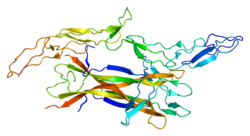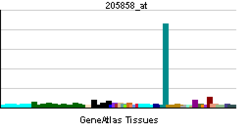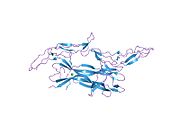- Low-affinity nerve growth factor receptor
-
"P75" redirects here. For the New Testament manuscript, see Papyrus 75. For Pentium processor at 75 MHz, see Intel P5 (microarchitecture).
The Low-Affinity Nerve Growth Factor Receptor (also called the LNGFR or p75 neurotrophin receptor) is one of the two receptor types for the neurotrophins, a family of protein growth factors that stimulate neuronal cells to survive and differentiate. The precise function of the LNGFR is somewhat controversial, in contrast to the function of the high-affinity receptor family for the neurotrophins, the Trk receptor tyrosine kinases such as TrkA.
Contents
The Neurotrophins
The neurotrophins are composed of four proteins, all of which bind to the LNGFR: Nerve Growth Factor (NGF), Brain Derived Neurotrophic Factor (BDNF), Neurotrophin-3 (NT-3), and Neurotrophin-4 (NT-4).
Nerve growth factor, the prototypical growth factor, is a protein secreted by a neuron's target. NGF is critical for the survival and maintenance of sympathetic and sensory neurons. NGF is released from the target cells, binds to and activates its high-affinity receptor (TrkA), and is internalized into the responsive neuron. The NGF/TrkA complex is subsequently trafficked back to the cell body. This movement of NGF from axon tip to soma is thought to be involved in the long-distance signaling of neurons.
The activation of TrkA by NGF is critical in inducing the survival and differentiation caused by this growth factor.
However, NGF binds at least two receptors on the surface of cells that are capable of responding to this growth factor, TrkA (pronounced "Track A") and the LNGFR.
The Trk family of receptor tyrosine kinases
TrkA is a receptor tyrosine kinase (meaning it mediates its actions by causing the addition of phosphate molecules on certain tyrosines in the cell, activating cellular signaling). There are other related Trk receptors, TrkB and TrkC. Also, there are other neurotrophic factors structurally related to NGF: BDNF (for Brain-Derived Neurotrophic Factor), NT-3 (for Neurotrophin-3) and NT-4 (for Neurotrophin-4). While TrkA mediates the effects of NGF, TrkB binds and is activated by BDNF, NT-4, and NT-3, and TrkC binds and is activated only by NT-3.
The role of the LNGFR
As opposed to TrkA, the LNGFR plays a somewhat less clear role in NGF biology. Some researchers have shown the LNGFR binds and serves as a "sink" for neurotrophins. Cells that express both the LNGFR and the Trk receptors might, therefore, have a greater activity, since they have a higher "microconcentration" of the neurotrophin. It has also been shown, however, that, in the absence of a co-expressed TrkA, the LNGFR may signal a cell to die via apoptosis; so, therefore, cells expressing the LNGFR in the absence of Trk receptors may die rather than live in the presence of a neurotrophin.[1]
Recent research has suggested a number of roles for the LNGFR, including in development of the eyes and sensory neurons,[2][3] and in repair of muscle and nerve damage in adults.[4][5][6]
Interactions
Low-affinity nerve growth factor receptor has been shown to interact with PRKACB,[7] FSCN1,[8] TRAF4,[9][10] Nerve growth factor,[11][12] TRAF2,[9] NDN,[13][14][15] NGFRAP1[16] and MAGEH1.[15]
References
- ^ Citation: Ibáñez, 2002
- ^ Nicol GD (October 2008). "Nerve growth factor, sphingomyelins, and sensitization in sensory neurons". Sheng Li Xue Bao : [Acta Physiologica Sinica] 60 (5): 603–4. PMID 18958367.
- ^ Di Girolamo N, Sarris M, Chui J, Cheema H, Coroneo MT, Wakefield D (December 2008). "Localization of the low-affinity nerve growth factor receptor p75 in human limbal epithelial cells". Journal of Cellular and Molecular Medicine 12 (6B): 2799–811. doi:10.1111/j.1582-4934.2008.00290.x. PMID 19210757.
- ^ Chen LW, Yung KK, Chan YS, Shum DK, Bolam JP (December 2008). "The proNGF-p75NTR-sortilin signalling complex as new target for the therapeutic treatment of Parkinson's disease". CNS & Neurological Disorders Drug Targets 7 (6): 512–23. doi:10.2174/187152708787122923. PMID 19128208.
- ^ Kocsis JD, Lankford KL, Sasaki M, Radtke C (June 2009). "Unique in vivo properties of olfactory ensheathing cells that may contribute to neural repair and protection following spinal cord injury". Neuroscience Letters 456 (3): 137–42. doi:10.1016/j.neulet.2008.08.093. PMC 2713444. PMID 19429149. http://www.pubmedcentral.nih.gov/articlerender.fcgi?tool=pmcentrez&artid=2713444.
- ^ Deponti D, Buono R, Catanzaro G, Palma CD, Longhi R, Meneveri R, Bresolin N, Bassi MT, Cossu G, Clementi E, Brunelli S (June 2009). "The Low Affinity Receptor for Neurotrophins p75NTR Plays a Key Role for Satellite Cell Function in Muscle Repair Acting via RhoA". Molecular Biology of the Cell 20 (16): 3620–7. doi:10.1091/mbc.E09-01-0012. PMC 2777922. PMID 19553472. http://www.pubmedcentral.nih.gov/articlerender.fcgi?tool=pmcentrez&artid=2777922.
- ^ Higuchi, Haruhisa; Yamashita Toshihide, Yoshikawa Hideki, Tohyama Masaya (Apr. 2003). "PKA phosphorylates the p75 receptor and regulates its localization to lipid rafts". EMBO J. (England) 22 (8): 1790–800. doi:10.1093/emboj/cdg177. ISSN 0261-4189. PMC 154469. PMID 12682012. http://www.pubmedcentral.nih.gov/articlerender.fcgi?tool=pmcentrez&artid=154469.
- ^ Shonukan, Oluwatoyin; Bagayogo Issa, McCrea Pierre, Chao Moses, Hempstead Barbara (Jun. 2003). "Neurotrophin-induced melanoma cell migration is mediated through the actin-bundling protein fascin". Oncogene (England) 22 (23): 3616–23. doi:10.1038/sj.onc.1206561. ISSN 0950-9232. PMID 12789270.
- ^ a b Ye, X; Mehlen P, Rabizadeh S, VanArsdale T, Zhang H, Shin H, Wang J J, Leo E, Zapata J, Hauser C A, Reed J C, Bredesen D E (Oct. 1999). "TRAF family proteins interact with the common neurotrophin receptor and modulate apoptosis induction". J. Biol. Chem. (UNITED STATES) 274 (42): 30202–8. doi:10.1074/jbc.274.42.30202. ISSN 0021-9258. PMID 10514511.
- ^ Krajewska, M; Krajewski S, Zapata J M, Van Arsdale T, Gascoyne R D, Berern K, McFadden D, Shabaik A, Hugh J, Reynolds A, Clevenger C V, Reed J C (Jun. 1998). "TRAF-4 expression in epithelial progenitor cells. Analysis in normal adult, fetal, and tumor tissues". Am. J. Pathol. (UNITED STATES) 152 (6): 1549–61. ISSN 0002-9440. PMC 1858434. PMID 9626059. http://www.pubmedcentral.nih.gov/articlerender.fcgi?tool=pmcentrez&artid=1858434.
- ^ Nykjaer, Anders; Lee Ramee, Teng Kenneth K, Jansen Pernille, Madsen Peder, Nielsen Morten S, Jacobsen Christian, Kliemannel Marco, Schwarz Elisabeth, Willnow Thomas E, Hempstead Barbara L, Petersen Claus M (Feb. 2004). "Sortilin is essential for proNGF-induced neuronal cell death". Nature (England) 427 (6977): 843–8. doi:10.1038/nature02319. PMID 14985763.
- ^ Lee, R; Kermani P, Teng K K, Hempstead B L (Nov. 2001). "Regulation of cell survival by secreted proneurotrophins". Science (United States) 294 (5548): 1945–8. doi:10.1126/science.1065057. ISSN 0036-8075. PMID 11729324.
- ^ Kuwako, Ken-ichiro; Taniura Hideo, Yoshikawa Kazuaki (Jan. 2004). "Necdin-related MAGE proteins differentially interact with the E2F1 transcription factor and the p75 neurotrophin receptor". J. Biol. Chem. (United States) 279 (3): 1703–12. doi:10.1074/jbc.M308454200. ISSN 0021-9258. PMID 14593116.
- ^ Bronfman, Francisca C; Tcherpakov Marianna, Jovin Thomas M, Fainzilber Mike (Apr. 2003). "Ligand-induced internalization of the p75 neurotrophin receptor: a slow route to the signaling endosome". J. Neurosci. (United States) 23 (8): 3209–20. PMID 12716928.
- ^ a b Tcherpakov, Marianna; Bronfman Francisca C, Conticello Silvestro G, Vaskovsky Anna, Levy Zehava, Niinobe Michio, Yoshikawa Kazuaki, Arenas Ernest, Fainzilber Mike (Dec. 2002). "The p75 neurotrophin receptor interacts with multiple MAGE proteins". J. Biol. Chem. (United States) 277 (51): 49101–4. doi:10.1074/jbc.C200533200. ISSN 0021-9258. PMID 12414813.
- ^ Mukai, J; Hachiya T, Shoji-Hoshino S, Kimura M T, Nadano D, Suvanto P, Hanaoka T, Li Y, Irie S, Greene L A, Sato T A (Jun. 2000). "NADE, a p75NTR-associated cell death executor, is involved in signal transduction mediated by the common neurotrophin receptor p75NTR". J. Biol. Chem. (UNITED STATES) 275 (23): 17566–70. doi:10.1074/jbc.C000140200. ISSN 0021-9258. PMID 10764727.
Further reading
- Buxser S, Puma P, Johnson G (10 February 1985). "Properties of the nerve growth factor receptor. Relationship between receptor structure and affinity". Journal of Biological Chemistry 260 (3): 1917–26. PMID 2981877. http://www.jbc.org/cgi/content/abstract/260/3/1917.
- Glass D, Nye S, Hantzopoulos P, Macchi M, Squinto S, Goldfarb M, Yancopoulos G (1991). "TrkB mediates BDNF/NT-3-dependent survival and proliferation in fibroblasts lacking the low affinity NGF receptor". Cell 66 (2): 405–13. doi:10.1016/0092-8674(91)90629-D. PMID 1649703. http://www.cell.com/content/article/abstract?uid=PII009286749190629D.
- Ibáñez C (2002). "Jekyll-Hyde neurotrophins: the story of proNGF". Trends in Neurosciences 25 (6): 284–6. doi:10.1016/S0166-2236(02)02169-0. PMID 12086739.
- Radeke M, Misko T, Hsu C, Herzenberg L, Shooter E (1987). "Gene transfer and molecular cloning of the rat nerve growth factor receptor". Nature 325 (6105): 593–597. doi:10.1038/325593a0. PMID 3027580. http://www.nature.com/nature/journal/v325/n6105/abs/325593a0.html.
PDB gallery External links
Receptors: growth factor receptors Type I cytokine receptor Receptor protein serine/threonine kinase Receptor tyrosine kinase Fibroblast growth factor (1, 2, 3, 4)
Nerve growth factors: high affinity Trk (TrkA, TrkB, TrkC)
Somatomedin (Insulin-like growth factor 1)
VEGF (1, 2, 3)Tumor necrosis factor receptor Nerve growth factors: Low affinity/p75Ig superfamily Other/ungrouped 1-50 CD1 (a-c, 1A, 1D, 1E) · CD2 · CD3 (γ, δ, ε) · CD4 · CD5 · CD6 · CD7 · CD8 (a) · CD9 · CD10 · CD11 (a, b, c) · CD13 · CD14 · CD15 · CD16 (A, B) · CD18 · CD19 · CD20 · CD21 · CD22 · CD23 · CD24 · CD25 · CD26 · CD27 · CD28 · CD29 · CD30 · CD31 · CD32 (A, B) · CD33 · CD34 · CD35 · CD36 · CD37 · CD38 · CD39 · CD40 · CD41 · CD42 (a, b, c, d) · CD43 · CD44 · CD45 · CD46 · CD47 · CD48 · CD49 (a, b, c, d, e, f) · CD5051-100 CD51 · CD52 · CD53 · CD54 · CD55 · CD56 · CD57 · CD58 · CD59 · CD61 · CD62 (E, L, P) · CD63 · CD64 (A, B, C) · CD66 (a, b, c, d, e, f) · CD68 · CD69 · CD70 · CD71 · CD72 · CD73 · CD74 · CD78 · CD79 (a, b) · CD80 · CD81 · CD82 · CD83 · CD84 · CD85 (a, d, e, h, j, k) · CD86 · CD87 · CD88 · CD89 · CD90 · CD91- CD92 · CD93 · CD94 · CD95 · CD96 · CD97 · CD98 · CD99 · CD100101-150 CD101 · CD102 · CD103 · CD104 · CD105 · CD106 · CD107 (a, b) · CD108 · CD109 · CD110 · CD111 · CD112 · CD113 · CD114 · CD115 · CD116 · CD117 · CD118 · CD119 · CD120 (a, b) · CD121 (a, b) · CD122 · CD123 · CD124 · CD125 · CD126 · CD127 · CD129 · CD130 · CD131 · CD132 · CD133 · CD134 · CD135 · CD136 · CD137 · CD138 · CD140b · CD141 · CD142 · CD143 · CD144 · CD146 · CD147 · CD148 · CD150151-200 CD151 · CD152 · CD153 · CD154 · CD155 · CD156 (a, b, c) · CD157 · CD158 (a, d, e, i, k) · CD159 (a, c) · CD160 · CD161 · CD162 · CD163 · CD164 · CD166 · CD167 (a, b) · CD168 · CD169 · CD170 · CD171 · CD172 (a, b, g) · CD174 · CD177 · CD178 · CD179 (a, b) · CD181 · CD182 · CD183 · CD184 · CD185 · CD186 · CD191 · CD192 · CD193 · CD194 · CD195 · CD196 · CD197 · CDw198 · CDw199 · CD200201-250 CD201 · CD202b · CD204 · CD205 · CD206 · CD207 · CD208 · CD209 · CDw210 (a, b) · CD212 · CD213a (1, 2) · CD217 · CD218 (a, b) · CD220 · CD221 · CD222 · CD223 · CD224 · CD225 · CD226 · CD227 · CD228 · CD229 · CD230 · CD233 · CD234 · CD235 (a, b) · CD236 · CD238 · CD239 · CD240CE · CD240D · CD241 · CD243 · CD244 · CD246 · CD247- CD248 · CD249251-300 CD252 · CD253 · CD254 · CD256 · CD257 · CD258 · CD261 · CD262 · CD264 · CD265 · CD266 · CD267 · CD268 · CD269 · CD271 · CD272 · CD273 · CD274 · CD275 · CD276 · CD278 · CD279 · CD280 · CD281 · CD282 · CD283 · CD284 · CD286 · CD288 · CD289 · CD290 · CD292 · CDw293 · CD294 · CD295 · CD297 · CD298 · CD299301-350 Cytokine receptors Chemokine receptor
(GPCRs)OtherTNF receptor 1-1011-2021-25JAK-STAT OtherIg superfamily IL-17 family S/T Categories:- Human proteins
- Clusters of differentiation
- Cytokine receptors
- Neurochemistry
Wikimedia Foundation. 2010.



